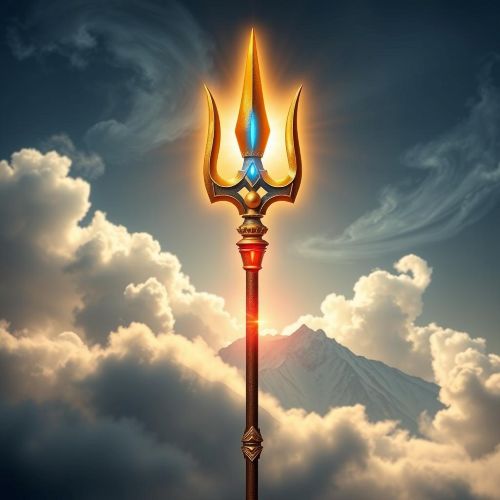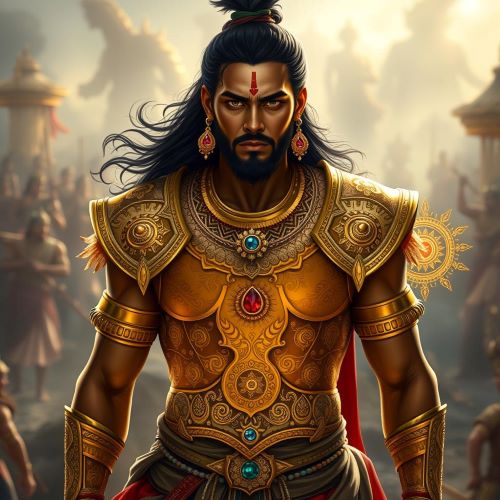Narayanastra : The Divine Missile
Narayanastra
Introduction
Among the divine weapons described in Hindu mythology, the Narayanastra holds a unique place for its destructive might and its deep spiritual symbolism. Associated with Lord Vishnu in his Narayana form, this celestial missile is more than just a weapon of war—it is a divine force that tests the humility and devotion of its target. Unlike ordinary astras that rely on sheer physical destruction, the Narayanastra responds to the emotions of those it is aimed at, sparing only those who surrender completely. This dual nature of being both an instrument of cosmic wrath and a trial of surrender makes the Narayanastra one of the most fascinating astras in ancient Indian epics and Puranic literature.
Origins
The origins of the Narayanastra trace back to sacred Hindu texts, including the Mahabharata, the Ramayana, the Bhagavata Purana, and the Ahirbudhnya Samhita. The weapon derives its name from Narayana, a supreme manifestation of Vishnu. According to the Vishnu Purana, Vishnu created this devastating weapon during the eternal battles between the devas and the asuras, ensuring the protection of dharma and the cosmic balance.
The Ahirbudhnya Samhita, a Pāñcarātra text, further elaborates on its creation. It explains that the Sudarshana Chakra was born from Vishnu’s divine energy, and from its immense radiance, countless astras, including the Narayanastra, came into existence. The text also highlights the dialogue between Sage Narada and Shiva, in which Shiva describes how Vishnu generated divine weapons to guard the universe against forces of chaos. In this way, the Narayanastra was not merely a tool of destruction but also a divine safeguard, ensuring that cosmic order was preserved against those who strayed into adharma.
Think you know your myths and legends? Dive into the world of ancient stories and test your knowledge with our engaging quizzes on Mythlok!
Powers
The powers of the Narayanastra surpass those of most celestial weapons described in Indian mythology. When invoked, the sky becomes filled with a blinding radiance, often compared to the brilliance of a thousand suns. From this effulgence, countless projectiles—chakras, arrows, spears, and maces—descend upon the enemy. Unlike other astras, its potency is linked to the target’s response. The more resistance offered, the more relentless and destructive the assault becomes.
This peculiar quality gives the Narayanastra a moral dimension: only by surrendering completely can one survive its fury. Submission here does not symbolize weakness but recognition of divine supremacy. If the intended victim lays down arms and bows in humility, the weapon halts and disperses harmlessly. If defiance continues, annihilation is certain. The Mahabharata describes that when Ashvatthama released the Narayanastra, eleven Rudras appeared alongside it, signifying its cosmic ferocity.
The Narayanastra is also classified among the Mantramukta weapons—those invoked and controlled purely by sacred mantras. Unlike physical weapons or even astras that can be countered by other astras, the Narayanastra admits no conventional defense. Its very nature demonstrates the power of surrender and detachment, making it as much a spiritual trial as a weapon of war.
Owners/Users
The Narayanastra was not widely distributed, given its unparalleled destructive power. Its association remained largely with figures who had divine sanction or were directly connected to Vishnu.
In the Ramayana, Lord Rama is said to have possessed the Narayanastra, though he did not actively use it. Meghanada (also known as Indrajit), son of Ravana, invoked this weapon during his final confrontation with Lakshmana. Yet the weapon refused to harm Lakshmana, as he was the incarnation of Adishesha, the eternal serpent of Vishnu, illustrating its divine allegiance.
The Mahabharata provides the most famous instance of its use. Ashvatthama, son of Dronacharya, received the Narayanastra from his father. Drona himself had been blessed with the weapon by Narayana and later passed it on to his son. Ashvatthama deployed it against the Pandavas in the heat of the Kurukshetra war, unleashing its devastating power.
Other references appear in the Bhagavata Purana, where Dhruva, the young devotee of Vishnu, invoked the Narayanastra in his battle with the Yakshas. In another episode, Krishna himself used it to counter Shiva’s Pashupatastra during his confrontation with Banasura. These accounts show that the Narayanastra was entrusted only to those aligned with divine will, never to ordinary mortals.
Instances used
The most detailed description of the Narayanastra’s use comes from the Mahabharata, specifically in the Drona Parva. After the death of Drona, Ashvatthama’s fury led him to invoke the Narayanastra against the Pandava army. The heavens darkened, and from the sky rained countless divine weapons. Terrified, the Pandava forces looked to Krishna for guidance. Recognizing its nature, Krishna ordered everyone to abandon their weapons and submit to the astra. Most complied immediately, but Bhima, unwilling to lay down arms, resisted. As a result, the weapon concentrated its fury upon him, nearly overwhelming him before Krishna and his brothers forced him into submission, saving his life. This event highlights the weapon’s role not just as an instrument of destruction but as a spiritual lesson about humility and obedience to divine order.
In the Ramayana, Meghanada attempted to use the Narayanastra against Lakshmana during their climactic battle. However, because Lakshmana was none other than Adishesha, the eternal companion of Vishnu, the astra refused to harm him, once again proving its divine intelligence and loyalty to Vishnu’s manifestations.
The Bhagavata Purana records Dhruva invoking the Narayanastra during his campaign against the Yakshas. The astra manifested its brilliance and ferocity, scattering Dhruva’s enemies and reaffirming his place as a favored devotee of Vishnu. Another account describes Krishna employing the Narayanastra to counter the devastating Pashupatastra of Shiva during his struggle with Banasura, demonstrating the supremacy of this weapon even among the pantheon of divine astras.
An important limitation of the Narayanastra is that it can only be used once in a war. Attempting to invoke it a second time results in the weapon turning upon the wielder’s own forces. This restriction ensured that it could never be abused for reckless destruction, preserving its sanctity as a divine safeguard rather than a weapon of ambition.
Frequently Asked Questions
Lorem ipsum dolor sit amet, consectetur adipiscing?
Lorem ipsum dolor sit amet, consectetur adipiscing elit. Praesent convallis vestibulum justo, ac tincidunt nunc vehicula quis. Nullam id dolor quis orci malesuada feugiat. Curabitur aliquet libero at urna ullamcorper, ac ultricies nulla dapibus.
Lorem ipsum dolor sit amet, consectetur adipiscing?
Lorem ipsum dolor sit amet, consectetur adipiscing elit. Praesent convallis vestibulum justo, ac tincidunt nunc vehicula quis. Nullam id dolor quis orci malesuada feugiat. Curabitur aliquet libero at urna ullamcorper, ac ultricies nulla dapibus.
Lorem ipsum dolor sit amet, consectetur adipiscing?
Lorem ipsum dolor sit amet, consectetur adipiscing elit. Praesent convallis vestibulum justo, ac tincidunt nunc vehicula quis. Nullam id dolor quis orci malesuada feugiat. Curabitur aliquet libero at urna ullamcorper, ac ultricies nulla dapibus.
Lorem ipsum dolor sit amet, consectetur adipiscing?
Lorem ipsum dolor sit amet, consectetur adipiscing elit. Praesent convallis vestibulum justo, ac tincidunt nunc vehicula quis. Nullam id dolor quis orci malesuada feugiat. Curabitur aliquet libero at urna ullamcorper, ac ultricies nulla dapibus.
Lorem ipsum dolor sit amet, consectetur adipiscing?
Lorem ipsum dolor sit amet, consectetur adipiscing elit. Praesent convallis vestibulum justo, ac tincidunt nunc vehicula quis. Nullam id dolor quis orci malesuada feugiat. Curabitur aliquet libero at urna ullamcorper, ac ultricies nulla dapibus.
Watch
Source
Menon, R. (2006). The Mahabharata: A Modern Rendering. iUniverse.
Wisdomlib. (2012, June 29). Narayanastra, Narayana-astra, Nārāyaṇāstra: 6 definitions. Retrieved from https://www.wisdomlib.org/definition/narayanastra
Wikipedia contributors. (2022). Narayanastra. Wikipedia. https://en.wikipedia.org/wiki/Narayanastra
Singh, V. (2025, May 21). Astras in Hindu History: The Fusion of Myth and Science. Pixelirk. https://www.pixelirk.com/defense-tech/2025/05/21/astras-in-hindu-history-the-fusion-of-myth-and-science/\









